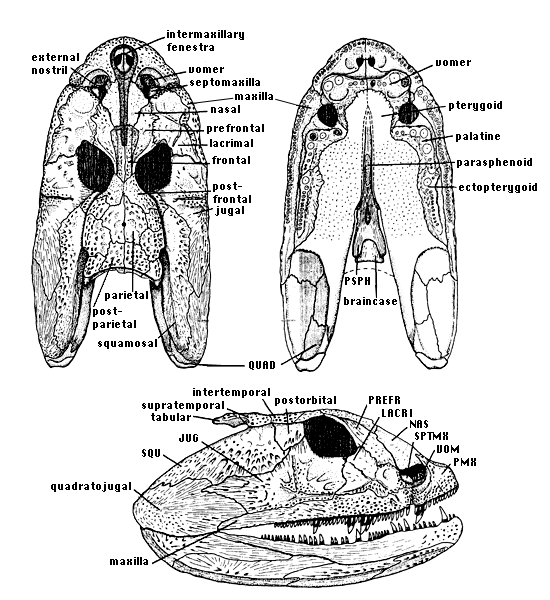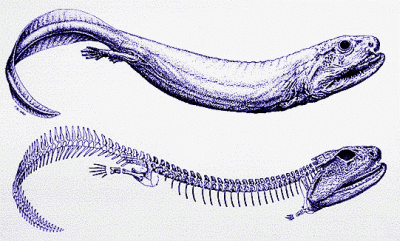
Crassigyrinus scoticus, life reconstruction, by Dmitry Bogdanov.
| Tetrapoda | ||
| The Vertebrates | Crassigyrinus |
| Vertebrates Home | Vertebrate | Vertebrate |
|
Abbreviated Dendrogram
Sarcopterygii
│
└─Tetrapoda
├─Acanthostega
└─┬─Ichthyostega
└─┬─Hynerpeton
└─┬─Tulerpeton
└─┬─Whatcheeriidae
└─┬─Crassigyrinus
└─┬─Colosteidae
│ └─Greererpeton
└─┬─Spathicephalus
└─┬─Baphetidae
├─Eucritta
└─Tetrapoda*
├─Temnospondyli
└─┬─Lepospondyli
└─Reptiliomorpha
|
Contents
Overview |
 Crassigyrinus scoticus, life reconstruction, by Dmitry Bogdanov. |
from Tree of Life website, Creative Commons Attribution-NonCommercial License
Crassigyrinus scoticus is an aquatic stem-tetrapod from the Late Mississippian and Early Pennsylvanian (Visean and basal Namurian) of Scotland, notable for combining bizarre specializations such as tiny forelimbs, with a number of primitive features such as the palatal construction. These have given rise to arguments about its taxonomic status. It is known from three skulls, one of which is in articulation with a fairly complete skeleton, and a couple of incomplete lower jaws. Not only is it taxonomically enigmatic, it must also have been a remarkable and formibable animal when alive.
The taxonomic position of Crassigyrinus has been the source of some debate. Panchen (1985) regarded it as related to "anthracosaurs", that is to say embolomeres plus Gephyrostegus and Eoherpeton. The basis for this rested upon a few characters such as "dark dentine" in the teeth and the form of the dermal bone ornament. Since then, other analyses have progressively severed the link with anthracosaurs. However, the most recent descriptive work (Clack 1998b) found that it clustered with Whatcheeria and the embolomeres. Since then, Ruta et al. (2003) in an analysis including representatives of all Palaeozoic tetrapod groups, concluded that it was the next most basal taxon after the Devonian forms, contrasting with Clack (2002b), who placed it as the next stem taxon above the Early Carboniferous family Whatcheeriidae.
The author disagrees with the move to restrict the vernacular term "tetrapod" to a crown clade (Gauthier et al., 1989). In this page, the term "tetrapod" and "stem-tetrapod" refer only to vertebrates with limbs and digits. (Refer to the lichen page on the Definition of the taxon Tetrapoda to get more information on this topic.)
The holotype skull, from Gilmerton near Edinburgh, shows a more or less undistorted and complete side view (Panchen 1973). The short pre-orbital region, quadrangular orbit and extended suspensorial region are clear from this specimen, as is the irregular, patchy nature of the dermal ornament. The snout is somewhat compressed, obscuring its structure. Further preparation of this and a second skull specimen showed that the naris was peculiar. Though relatively large, it included a cushion-shaped septomaxilla. A skull associated with a postcranial skeleton, from the Dora Bone Bed of Cowdenbeath, Fife, (Andrews et al. 1977, Panchen 1985) shows the skull table to be similar in structure to those of embolomeres, with unsutured junctions to the cheeks. In contrast to embolomeres, however, it had a primitive bone-pattern with supra-temporal/ postparietal contact. A notch between the skull table and the cheek has been interpreted as housing a spiracle, but the stapes is unknown.

Skull reconstructions of Crassigyrinus scoticus in dorsal (top right), ventral (top left) and lateral (below) views. Drawing copyright © 1997 J. A. Clack.
A third skull (BMNH 30532), also from Gilmerton, shows the palate very clearly, and indicates that Crassigyrinus had a combination of a very osteolepiform-like configuration of the vomers, and extremely specialized, massive palatal dentition. This specimen also shows more clearly than the other two, a bizarre fenestra between the premaxillae, which communicated with an anterior palatal fenestra (Clack 1998). The function of this structure is unknown. Large holes in the dorsal surface of the dentary housed the massive palatal teeth when the jaws were closed, a feature unique to Crassigyrinus. In other respects the lower jaws prove to be rather primitive in construction (Ahlberg and Clack 1998)

If the skull was bizarre, the postcranial skeleton to which it attached (left) was correspondingly weird. The humerus was extremely small, no longer than the longest dimension of the orbit. It retains some of the extra foramina seen in Ichthyostega and Acanthostega. The ulna and radius were similarly reduced making the forelimbs "ridiculously small" (Panchen and Smithson 1990). They articulated with the shoulder girdle at a point very close to the jaw joint. It is not known how many digits were present. Long curved ribs surrounded the body, attached to centra which were poorly ossified and formed ventral U-shaped supports for the persistent notochord. The hind limbs were relatively small compared with a more conventional tetrapod, but were not nearly so reduced as the forelimbs.
Crassigyrinus was a large, long-bodied, permanently aquatic predator, with fearsome-looking teeth in a heavily reinforced skull. The snout in particular was consolidated and buttressed, and with a kinetic inertial jaw mechanism, would have produced a bone-smashing snap-trap. Its large eyes were probably adapted for use in murky coal-swampy water. Panchen (1985) envisaged it as behaviourally somewhat analgous to a Moray eel.
Crassigyrinus: C. scoticus
Carboniferous (Viséan) of Scotland
Tetrapoda ::: Whatcheeriidae + (Colosteidae ::: Tetrapoda*) + *.)
Limited ossification of vertebral centra, no occipital condyle. No anocleithrum. Cheek (very!) moveable on skull roof, like Reptiliomorpha, intercentra & pleurocentra roughly equal, orbits close to midline, tabular does not contact parietal.
Note: The current (2002) belief is that Crassigyrinus is a rather weird anthracosaur. Eventually, we will get around to moving it there. Meanwhile, the current belief is also that Crassigyrinus is one of the major causes of cladogram instability in this area. Accordingly, until things settle down a bit, it will stay in the old neighborhood. ATW. Update: current cladistic analyses (Clack 1998b, Clack 2002b, Ruta et al. 2003, Ruta et al 2003b, Clack & Finney 2005, Warren 2007, Ruta & Bolt 2008) uniformly place Crassigyrinus just before or just above the Whatcheeriidae, and before Colosteidae and other basal taxa. Therefore the anthracosaurian traits are more likely to be either convergences or plesiomorphic. Crassigyrinus is best interpreted as a very porimitive, secondarily totally aquatic, amphibian (tetrapod). MAK111112
Comment: A bizaare, totally aquatic form. Along with the whatcheeriids, the most primitive pentadactyl (five-fingered) animal.
Links: link. 990926.
Images: Crassigyrinus scoticus,life reconstruction by Dmitry Bogdanov Wikipedia, GNU Free Documentation/Creative Commons Attribution Skull reconstruction copyright © 1997 J. A. Clack, from Clack, 2006 (Tree of Life Page); skeletal and life reconstructions from Panchen & Smithson 1990 Copyright 1990 Royal Society of Edinburgh
checked ATW040813, new page MAK111112